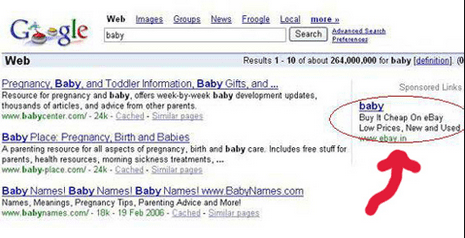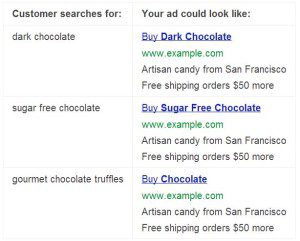 I know you’ve noticed this simple fact of Google life: some ads features words in bold, giving them a stronger visual pull than others. I’ve run across support forums with users wondering how to format their ads to look like this. But the truth is, you can just “ask” Google to bold your ads. And I don’t mean you have to contact a Google representative and hope for the best.
I know you’ve noticed this simple fact of Google life: some ads features words in bold, giving them a stronger visual pull than others. I’ve run across support forums with users wondering how to format their ads to look like this. But the truth is, you can just “ask” Google to bold your ads. And I don’t mean you have to contact a Google representative and hope for the best.
Google has a specific algorithm for determining these highlighted words. All you have to do is say the magic words. Literally. When your ad text matches one or more of the user’s search terms, Google automatically highlights those terms in your ad–IF they exist in your ad, and that’s the kicker. Many retailers don’t make the most of this Google feature, so today we’re going to introduce the two routes to achieving this (and why we like one more than the other).
Keyword Insertion
The easiest step you can take to start highlighting your ads is dynamic keyword insertion. This feature allows Google to automatically insert the keyword where you designate it in the ad text, so your ad will reflect the search term. There are various ways you can use this feature, but it must be used carefully, due to a few restrictions.
Firstly, if you’re not careful in how you use keyword insertion, you can end up with ads that are either grammatically awkward at best, or just make no sense at all, like these humorous examples from eBay.

Your ads can even get disapproved due to keyword insertion if the grammar or content accidentally violates AdWords policy on certain keywords. Also, since all ad text lines have character limits, not all keywords can be included. Thus, to use keyword insertion, you must provide a “default text” that will be used if the search term is too long. In the example below, the text that comes after the colon specifies what text will be used if the search term pushes the headline over the allotted 25 characters.
With keyword insertion, you can also specify various capitalization methods for the dynamically inserted keywords, displayed in the table below (borrowed from Google).
As you can see in the table below, keyword insertion creates a very flexible ad that can cover your bases with a variety of keywords from your ad group while still running the same basic ad.
However, while this is less work up front, relying on keyword insertion does not create the true relevancy you need to really optimize your campaigns. This option may get you noticed on the search results page more often, but it necessitates general ad text and, more importantly, general landing pages. This hurts your Quality Score and overall profitability. That’s why we recommend your second option when it comes to asking Google to highlight your ads…
Granular Ad Groups
Highly relevant, specific ad groups have several profit-making advantages over disorganized campaigns, as we discussed in an earlier blog post. In this particular case, granular ad groups will give you the power to create highly relevant, targeted ads based on tight groups of keywords, which will in turn auto-optimize your ads for Google’s highlighting algorithm.
But not only will your headlines, and possibly your body text, feature bold formatting, but you will also be able to write specific ads with specific landing pages. This kind of ad writing boosts your Quality Score and often leads to higher conversions.
Granted, this is not something you can do overnight, but it is an optimization that we’ve seen dramatically improve profitability in our clients time and time again. I don’t think I’m jumping out on a limb to say I know you would like more profitable campaigns too. So, while keyword insertion is a quick fix that can help your visibility, it will not ultimately bring you the healthy AdWords campaign you want.
What this all boils down to is this: Google rewards relevance. It will highlight relevant ads with bold text. It will reward relevant landing pages with high Quality Score. And it will reward advertisers who learn how to be exceptionally relevant with exceptional results.
Interested in learning more AdWords tips and tricks to make the most of your campaigns? Download our most popular special report, Default AdWords Settings that Kill Retailer Profitability.





